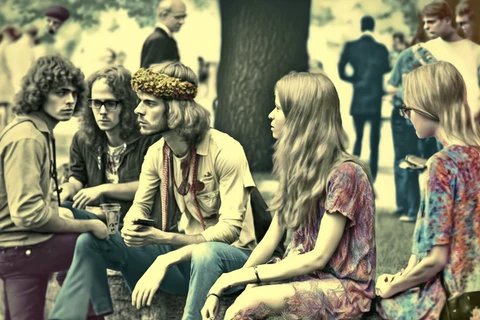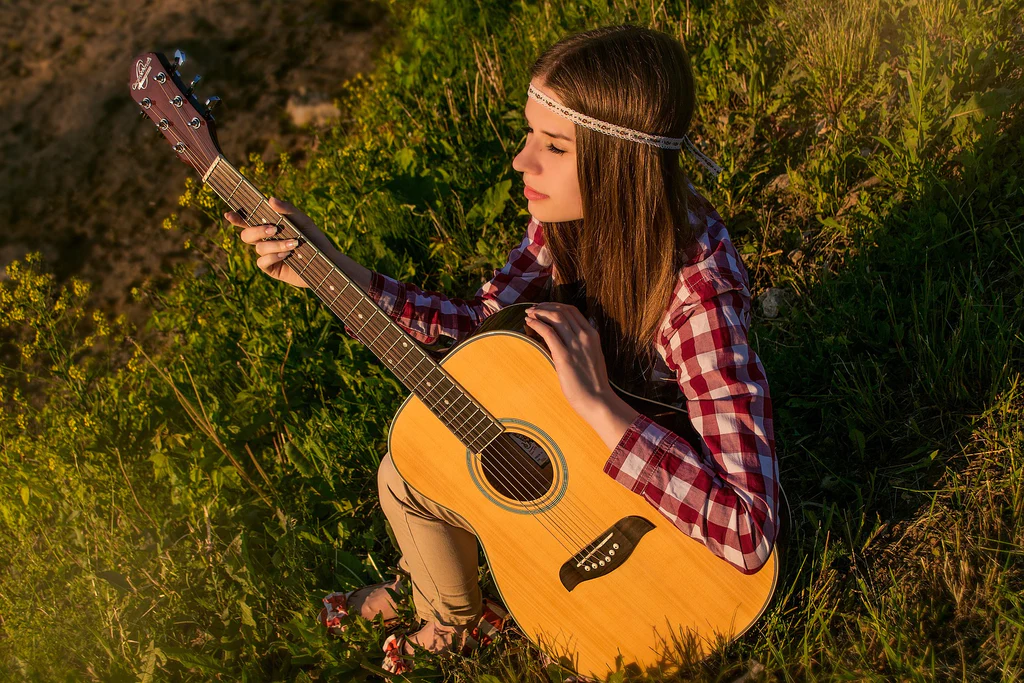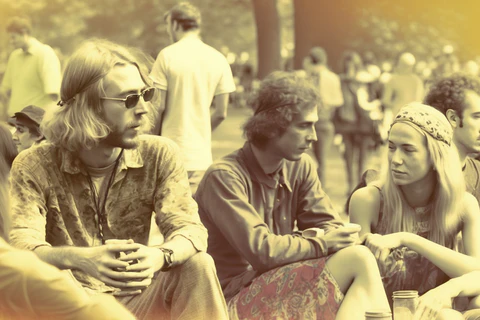Who Were Hippies?

Hippies were a subculture of young people who emerged in the late 1960s and early 1970s. They are typically associated with anti-war, countercultural, environmentalist, or free love movements as well as alternative lifestyles such as communal living. Hippies embraced liberal views on drug use, sexuality, and social issues. They believed that peace could be achieved through understanding and tolerance for different beliefs and values.
The hippie look was characterized by long hair, bell-bottom jeans or tie-dye clothing, beads, and jewelry made from natural materials like wood or leather. Sandals were popular footwear among hippies since they did not conform to traditional fashion standards of the day. Many also wore headbands with feathers or other decorations to express their individuality and show solidarity with their peers in the movement. Hippies dressed often in bright-colored clothing made from vintage fabrics like velvet or lace which they paired with fringed jackets and vests decorated with embroidery patches depicting peace symbols, flowers, or Native American designs.
What set hippies apart was their attitude toward life which sought to challenge societal norms through nonconformity while promoting respect for others regardless of race, gender identity, or sexual orientation.
Their music reflected this mindset through its focus on spiritual enlightenment rather than material possessions; psychedelic rock songs featured themes of peace activism instead of romantic love ballads commonly heard at that time period in mainstream pop culture music genres like Motown soul and bubblegum pop songs about teenage crushes. In addition to attending concerts at outdoor festivals celebrating freedom of expression during summer months, hippie gatherings were often held indoors where members would discuss topics ranging from world politics to astrology.
Hippie culture has had a lasting influence on modern society as evidenced by increased acceptance of diversity today compared to when it first began. The legacy left behind by these trailblazers can still be seen in art forms such as folk music, literature exploring alternate realities beyond our own reality, and even fashion trends inspired by those original bohemian style garments worn over half a century ago.
Defining the Hippie Movement: A Brief Overview of the Counterculture
The hippie movement was a counterculture of the 1960s and 1970s that aimed to express an alternative lifestyle, which included promoting peace, love, and freedom. This wave of nonconformity was mainly concentrated in North America and Europe but had its roots in India’s ancient religious traditions. Hippies rejected traditional values such as materialism, consumerism, and patriarchy.

They embraced new ideas around communal living arrangements; ecological awareness; drug experimentation (particularly with LSD); meditation; yoga practices; natural healing techniques like herbal medicine; live music events called “Be-ins”; clothing styles such as tie-dye shirts and bell bottom jeans; sexual liberation through nudity at beaches or communes like the ones established by members of the Hog Farm Collective in California.
Hippies were often seen as people who didn’t conform to society’s expectations or follow mainstream rules – they wanted to create their own paths instead.
They advocated for civil rights issues and anti-war sentiments while embracing psychedelic drugs like LSD to experience what hippies believed were spiritual journeys into other realms of consciousness. Some hippies practiced free love where any consensual relationships between adults would be accepted regardless of gender or sexual orientation – something that was still frowned upon during this time period due to homophobia from society at large.
Hippie culture heavily influenced modern youth culture today through fashion trends, social media movements advocating for peace over violence/hatred towards one another (like #loveoverhate), and environmental causes championed by groups like Greenpeace International among others – all inspired by their predecessors from back then who wanted nothing more than a better world for everyone without judgment based on race/gender/sexual orientation, etc.
The Roots of Hippie Culture: Exploring the Beat Generation
The Beat Generation was a small group of American post-WWII writers and poets whose work heavily influenced the emergence of hippie culture. The Beats, as they were known, rejected the traditional values and conventions of their day in favor of exploring more alternative ways to live life. They wrote about counterculture topics such as sexual freedom, drug experimentation, and non-conformity. Many members of the Beat Generation are now considered icons for their influence on popular culture including Allen Ginsberg, Jack Kerouac, and William S Burroughs.
At its core, hippie culture was an offshoot of this movement that focused on peace activism rather than creative writing. Hippies embraced aspects of Eastern religions like Buddhism while rejecting what they saw as materialism and oppressive government control over citizens’ lives. As such there was a strong emphasis placed upon free expression in a dress with bright colors often being chosen by young adults who wanted to be different from their parent’s generation. Music also played an important role in establishing the identity associated with hippies; psychedelic rock bands like Jefferson Airplane or Grateful Dead became some of the most famous acts during this period due to their association with peace protests or other social movements at that time.
The language spoken by many people within these circles changed drastically from prior generations too; slang words like “groovy” or “far out” became commonplace among those who identified themselves as part of the Hippie Movement in order to express approval for something outside societal norms. While many members sought political change through peaceful protest others opted for a lifestyle rooted solely around personal spiritual exploration without any regard for public opinion whatsoever – something which would have been unheard of prior to this era.
Hippies and the Anti-War Movement: The Role of Youth Culture in Protesting the Vietnam War
The 1960s saw the emergence of youth culture and its involvement in protest movements. One such example was that of hippies, who made their presence felt during the anti-war movement against the Vietnam War. Hippies were mostly young adults who subscribed to a countercultural lifestyle, rejecting traditional values and espousing ideals of peace, love, freedom, and nonconformity. This gave them an important role in the anti-war movement which had been gaining momentum since 1964 when US President Lyndon Johnson sent troops to South Vietnam.
Hippies adopted different strategies for protesting the war including sit-ins, boycotts, and rallies at universities throughout America as well as public demonstrations with huge numbers attending at places like Washington DC’s Pentagon. As part of this effort, they created numerous slogans such as ‘Make Love Not War’ or ‘Hell No We Won’t Go.’. They also organized events such as concerts or festivals where they spread awareness about their cause while expressing themselves through music and art performances often featuring rock bands popular among their generation like The Beatles or Jimi Hendrix.
This allowed them to reach out to a wider audience on college campuses across America who may not have otherwise been exposed to political messages related to the war in Vietnam due to mainstream media outlets largely supporting it then. Consequently, these protests became increasingly successful over time until eventually leading up to a cease-fire agreement being signed between North Vietnam & South Vietnam in 1973 after nearly two decades of fighting for independence from foreign rule by US forces alongside other allied countries involved in it.
The Counterculture Movement: How Hippies Challenged Traditional Values
The counterculture movement of the 1960s and 70s was a powerful force in American society, and hippies were at its forefront. Born out of an idealistic spirit to challenge conventional values, hippie culture was based on principles of peace, love, and freedom. Hippies rejected traditional societal norms such as materialism, consumerism, conformity to gender roles, and other forms of oppression. Instead, they embraced alternative lifestyles such as communal living arrangements with shared resources; psychedelic drugs for spiritual exploration; rock music that celebrated individual expression; vegetarian diets; environmental activism, and more.
As part of their non-conformist stance against the establishment, hippies often adopted distinctive styles of clothing featuring bright colors or unusual patterns meant to make a statement about self-expression over conformity.
Long hair became a symbol for rejecting oppressive rules set by the government or religious authorities on how one should look or act in public spaces. In addition to fashion statements through clothing choices, hippies also used body art like tattoos as further expressions of independence from society’s expectations.
The social impact made by the hippie movement is still evident today in many aspects of popular culture including fashion trends inspired by 60s/70s era clothes;
Modern-day festivals celebrating free love ideals along with music performances; support for green initiatives protecting natural resources around the world – all inspired by original countercultural movements led by pioneering minds who had enough courage to stand up against traditional conventions.
Kesey and the Merry Pranksters: The Acid Tests and the Emergence of the Hippie Lifestyle
Ken Kesey and his Merry Pranksters were the vanguards of a new era. The legendary Acid Tests, which Kesey organized in 1965 and 1966, brought together like-minded individuals who sought to explore alternative ways of living. These tests served as precursors to the counterculture movement that would come to define the ’60s: hippies.
The Acid Tests were a series of events held by Kesey and his cohorts where LSD was taken by participants in an effort to open their minds up to new possibilities and experiences. While these events did not always occur under controlled conditions – many attendees had no prior knowledge or experience with hallucinogenic drugs – they proved influential in bringing forth a generation’s fascination with psychedelics, communal living, free love, music festivals, fashion trends such as tie-dye clothing, and more abstract concepts like nonconformity.
These events also helped introduce large numbers of people to one another; it is said that without these gatherings there may have never been enough people interested in similar ideals for what became known as “the hippie lifestyle” ever become reality on any significant scale. Thus Ken Kesey can be credited with helping ignite a cultural revolution that spanned continents; while hippies emerged first in California during this time period they soon spread out into other parts of America before eventually becoming popular across Europe too by 1967.
Woodstock Music Festival: The Culmination of Hippie Culture
In the summer of 1969, the Woodstock Music Festival marked a major milestone in hippie culture. Attended by over 400,000 people from all across America and Canada, this event was an iconic gathering that saw some of the greatest musical acts of its time grace its stage. It represented a powerful display of unity between different generations as well as members of various counterculture movements such as those who sought social justice and equal rights for minorities.
The music festival also provided an opportunity to celebrate free love and peace in what were otherwise turbulent times with many young Americans being drafted into war overseas. This sentiment resonated through the lyrics sung on stage by artists like Jimi Hendrix and Joan Baez during their performances which encouraged listeners to stay true to themselves no matter what obstacles they faced.
Woodstock provided attendees with more than just music though; it served as an outlet for expression through fashion too. Bright colors were seen everywhere along with flowy dresses and bell-bottom jeans that have since become staples among today’s youth fashionistas looking for inspiration from decades past. Woodstock remains one of history’s most influential events both musically and culturally due to its impact on how future generations viewed life outside traditional norms set by society at large.

The Legacy of the Hippie Beat Movement: How It Shaped Society and Art
The Hippie Beat movement, which emerged in the mid-1960s and rose to prominence throughout the 1970s, was a countercultural revolution that has had a lasting impact on both society and art. This influential subculture changed how people thought about fashion, music, politics, religion, and lifestyles. It sparked conversations around topics such as civil rights movements and sexual liberation.
Hippies advocated for peace and love through their clothing choices – usually bright colors or tie-dye garments – as well as through their musical performances at festivals such as Woodstock. They also sought to challenge existing power structures by staging protests against government policies they opposed. The movement’s emphasis on free expression enabled new forms of artistic expression like psychedelic rock bands whose songs were written about living life freely without boundaries or restrictions set by social conventions of the time period.
Though much of this cultural shift is now seen nostalgically in films such as Almost Famous (2000) or Forrest Gump (1994), it remains undeniable that hippie culture left its mark on history with its revolutionary ideas and unique way of thinking. It redefined what it meant to be an individual in society while pushing back against traditional norms in order to create something entirely new – from political views to fashion trends – that we still witness today decades later after its inception.
Conclusion
Well, folks, when it comes to hippies, there’s a whole lot more than meets the eye! The counterculture movement of the 1960s and 1970s swept through the Haight-Ashbury district of San Francisco like a groovy whirlwind, with many hippies flocking to the Summer of Love in 1967. Driven by a desire for peace, love, and freedom, these trailblazers of the youth movement sported beards, long hair, and vibrant hippie fashion, while opposing the war and embracing flower power.
From the early 1960s, the hippie counterculture movement gained momentum, with icons like Bob Dylan and Timothy Leary playing a significant role in shaping the social and cultural landscape. The movement also saw the rise of the Yippies, or the Youth International Party, who was deeply involved in the counterculture scene. Events like the “be-in” at San Francisco’s Golden Gate Park, and even attempts to “levitate the Pentagon,” showcased the spirit and influence of this revolutionary group.
As the movement progressed, important hippie events like Woodstock Music and Art Festival and gatherings in the Haight-Ashbury neighborhood further solidified their place in history. Though the counterculture faced its fair share of clashes and struggles – like drug addiction and the burning of draft cards – the hippies’ unwavering desire for peace and unity left an indelible mark on the world.

People Also Ask
How and when did the hippie movement start?
The hippie movement kicked off in the early 1960s as a counterculture movement, gaining steam in the U.S. by the mid-60s. It really took off in the summer of 1967, known as the “Summer of Love,” when thousands of young people flocked to the Haight and Ashbury streets in San Francisco.
They sought peace, freedom, and a break from societal norms, embracing beards, long hair, and the use of psychedelic drugs.
What role did music play in the hippie movement?
Music was a cornerstone of the hippie movement, helping to popularize counterculture ideals and bring members together. Iconic bands like Big Brother and the Holding Company, as well as legendary artists such as Bob Dylan, were integral to the scene. Music festivals, like Woodstock, served as gathering points where hippies could revel in their shared love for peace, freedom, and rock ‘n’ roll.
How did the hippie movement influence society and culture?
The hippie movement had a profound impact on American society and culture during the 1960s and 1970s. Members of the counterculture questioned traditional values, experimented with alternative lifestyles, and advocated for peace and love. They helped bring awareness to environmental issues, and their fashion choices, such as beards and long hair, influenced mainstream trends. The movement also spurred significant social and political changes, such as the end of the Vietnam War and the push for civil rights.





